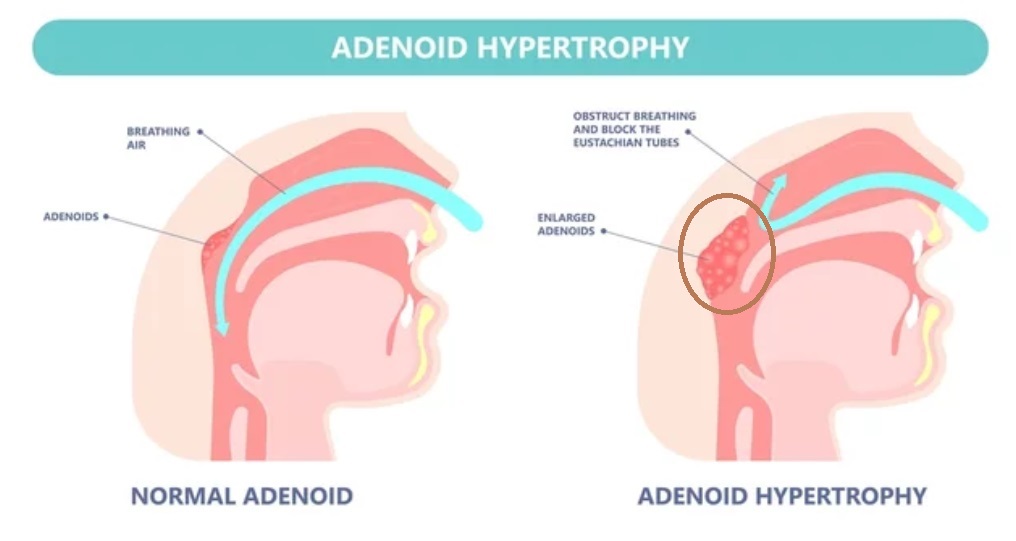WHAT ARE ADENOIDS?
The nasopharyngeal tonsils are commonly called as ADENOIDS. It is situated at the junction of the roof and posterior wall of the nasopharynx.
Adenoid tissue is present at birth.
It shows physiological enlargement up to the age of 6 years and then tends to atrophy at puberty and almost completely disappears by the age of 20.
FUNCTION OF ADENOIDS:
The function of the adenoids is related to immunity.
It is seen that they produce antibodies and play an important role in the development of immunological memory in younger children.
WHY AND WHEN DO THEY CAUSE TROUBLE?
Adenoids are subject to physiological enlargement in childhood.
Certain children have a tendency to have a generalized lymphoid tissue enlargement in which adenoids also take part.
Recurrent attacks of rhinitis, sinusitis or chronic tonsillitis may cause chronic adenoid infection and its enlargement.
Allergy of the upper respiratory tract may also contribute to the enlargement of adenoids.
CLINICAL FEATURES OF ADENOIDS:
Symptoms and signs depend not merely on the absolute size of the adenoid mass but are relative to the available space in the nasopharynx.
Enlarged and infected adenoids may cause —-
- NOSE SYMPTOMS
- EAR SYMPTOMS
- GENERAL SYMPTOMS
A. NOSE SYMPTOMS:
1. Nasal obstruction:
Nasal obstruction is the most common symptom. This leads to mouth breathing.
Nasal obstruction also interferes with feeding or suckling a child as respiration and feeding cannot take place simultaneously. A child with adenoid enlargement fails to thrive.
2. Nasal discharge:
It is partly due to choanal obstruction, as the normal nasal secretions cannot drain into the nasopharynx, and partly due to associated chronic rhinitis.
The child often has a wet bubbly nose.
3. Sinusitis:
Chronic maxillary sinusitis is commonly associated with adenoids.
It is due to the persistence of nasal discharge and infection.
Primary maxillary sinusitis may lead to infected and enlarged adenoids.
When adenoids are acutely inflamed, epistaxis can occur with nose blowing.
5. Voice change:
Voice changes due to nasal obstruction, which is toneless and loses nasal quality due to nasal obstruction.
B. EAR SYMPTOMS:
1. Eustachian Tube obstruction:
Adenoid mass blocks the Eustachian tube leading to a retracted tympanic membrane and conductive hearing loss.
2. Acute otitis media:
Recurrent attacks of acute otitis media or infection of middle ear may occur due to spread of infection via the Eustachian tube because the Eustachian tube is blocked due to adenoid hypertrophy.
3. Chronic suppurative otitis media:
CSOM or long-standing infection of the middle ear occurs if the otitis media fails to resolve in the presence of infected adenoids.
C. GENERAL SYMPTOMS:
1. Adenoid facies:
Chronic nasal obstruction and mouth breathing lead to a characteristic facial appearance called ADENOID FACIES.
The features of ADENOID FACIES, some of which are reversed after adenotonsillectomy, include:
- An elongated face
- Retrognathic mandible
- Dull expression face
- Dark circles under the eyes
- Persistent and prominent open mouth for breathing
- Pinched nose due to disuse atrophy of alae nasi
- Hitched up upper lip
- Open bite, protrusive maxilla, and buccal posterior crossbite
- Prominent and crowded upper teeth
- High arched hard palate because of the absence of moulding action of the tongue on the palate because the child has to always keep the mouth open for breathing.

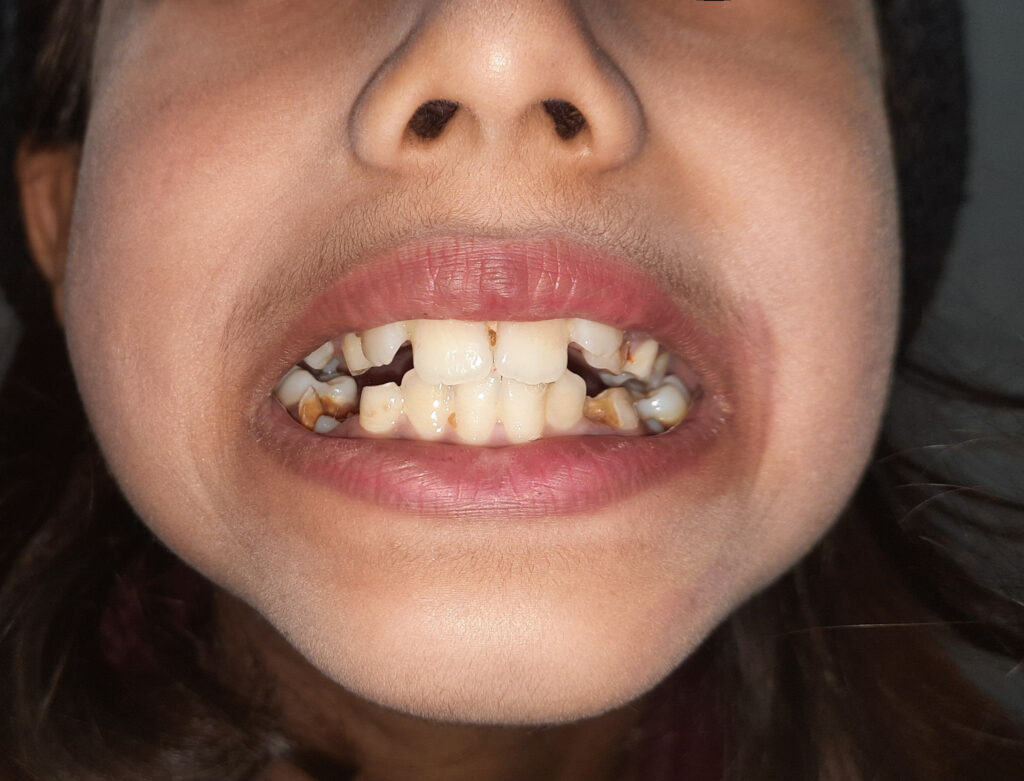
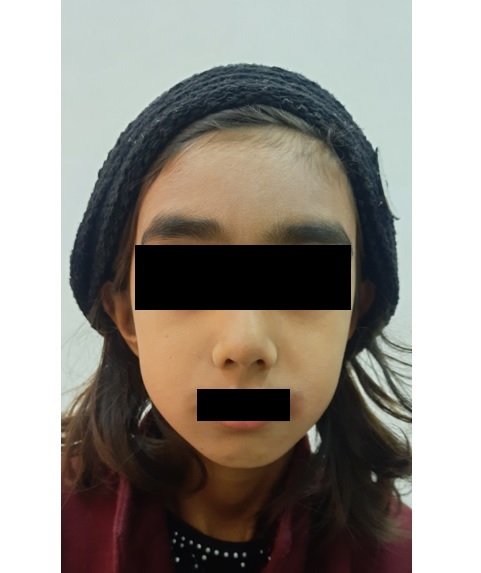
2. Pulmonary hypertension:
In long-standing nasal obstruction due to adenoid hypertrophy, the oxygen reaching to lungs is decreased so the blood pressure in pulmonary artery increases to carry the oxygen needed for tissues of body, which can cause pulmonary hypertension.
OTHER UNCOMMON but VERY IMPORTANT CLINICAL MANIFESTATIONS OF ADENOIDS are:
- Dysphagia (means Difficulty in swallowing)
- Restless or disturbed sleep.
- Enuresis (means involuntary urination at night in bed)
- Disturbance of growth or Growth stunting
- Failure to thrive (means failure to grow or to gain or maintain weight).
DIAGNOSIS / INVESTIGATIONS:
Examination of postnasal space is possible in some young children and an adenoid mass can be seen with a posterior rhinoscopy mirror.
Soft tissue lateral radiograph of the nasopharynx (aka X-ray Nasopharynx lateral view) will reveal the size of adenoid and also the extent to which nasopharyngeal air space has been compromised.
A detailed nasal examination should always be conducted to exclude other causes of nasal obstruction –
1. Nasal Endoscopy:
It gives a proper visualization of the size of adenoids and for clinical grading of adenoid size.
Preoperative assessment is recommended before adenoidectomy.
We must do the nasal endoscopy in the children whenever possible.
2. Ear Examination:
Since the adenoids invariably cause ear symptoms, so we must always examine the ear.
It may show —
- The presence of fluid in the middle ear (aka Otitis media with effusion or Serous otitis media) or
- The signs of Acute Otitis Media, or
- Retractions of the tympanic membrane.
3. Audiological Investigation:
Whenever the patient’s family member or guardian are complaining that the child is not hearing properly along with the nasal obstruction in the typical age group of 4 to 8 years of age; this is the peak age group, so in these cases, the audiological investigation must be done.
So, the test which is advised in the case of adenoid infection or hypertrophy are —
- Pure tone Audiometry, and
- Tympanometry
4. Radiological Investigations:
The doctor will ask for an x-ray of the nasopharynx lateral view to see the extent of the size of the nasopharynx and how much it is compromised.
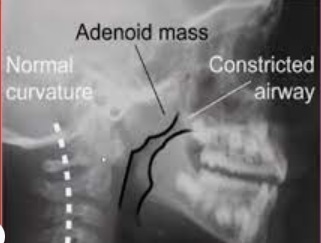
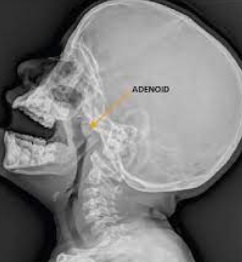
TREATMENT:
a) When symptoms are not marked —
- Breathing exercises,
- decongestant nasal drops, and
- antihistamines for any coexistent nasal allergy can cure the condition without the need for surgery.
b) When symptoms are marked, a surgical procedure known as ADENOIDECTOMY is done for the complete removal of adenoids.
ADENOIDECTOMY SURGERY:
Unlike tonsils which are located in the mouth, adenoids are found at the back of the nose in the nasopharynx. As such the adenoids would be located behind and above the soft palate.
By inserting a small camera or endoscope into the nose, the adenoids can be easily seen.
Once the decision is made to remove the adenoids, the patient is placed under general anesthesia and a mouth gag is placed to keep the mouth open.
A catheter is then inserted through the nose and out the mouth to retract the soft palate.
Through the mouth, the surgeon can indirectly visualize the adenoids using a dental mirror or indirect laryngoscopy mirror and proceed with the adenoid removal or curettage.
There are many other instruments like MICRODEBRIDER or COBLATION which can be used to remove the adenoids.
INDICATIONS OF ADENOIDECTOMY:
- When the patient is having chronic adenoid hypertrophy causing —-
– obstructive sleep apnea,
– severe nasal obstruction,
– craniofacial morphology problems (maxillary deformity, dentition problem), and
– excessive snoring,
These suggest that the size of the adenoids is significantly enlarged and adenoidectomy is indicated. - Adenoidectomy is also done in children above 3 years of age who require repeated grommet insertion.
Grommet insertion is done for the treatment of otitis media to drain the fluid in the middle ear. - Sometimes adenoidectomy is also done along with the primary grommet placement in cases with the additional nasal obstruction.
These nasal obstructions will always be confirmed by doing nasopharyngoscopy and x-ray of the nasopharynx.
HOME REMEDIES FOR ENLARGED ADENOIDS:
Most adults do not suffer from adenoiditis.
In fact, the adenoids begin shrinking naturally by the age of 5 and virtually disappear by the teen years.
Thus, adenoiditis is a condition primarily occurring in children.
There is no home remedy as such that can surely decrease the adenoid size but there are home remedies to decrease the severity of the symptoms caused by adenoiditis or adenoid hypertrophy.
1) Garlic:
The sulfur-containing compounds in garlic have strong antibacterial and anti-inflammatory properties that can help deal with symptoms caused by enlarged adenoids.
2. Cod liver oil:
It contains several nutrients, including selenium that support effective lymphatic flow. Thus, the essential fats in the oil help reduce inflammation, thus helping to decrease the swelling of the adenoids.
3. Ginger:
Ginger is another effective remedy for treating respiratory infections in both children and adults, thanks to its antibacterial, antiviral, and anti-inflammatory properties.
4. Saltwater gargle:
While warm water has a soothing effect on the sore throat, salt helps kill the microbes that cause the infection. Also, the salt will help relieve pain and bring down the swelling.
5. Honey:
Honey is an effective anti-inflammatory, and antibacterial agent, which can help reduce the symptoms as well as fight the cause of the problem.
6. Foods rich in vitamin C:
Vitamin C is an important nutrient for a growing child. This water-soluble vitamin supports the immune system and helps shorten the duration of any kind of infection, including enlarged adenoids.
7. Steam inhalation:
Steam is also beneficial for children with enlarged adenoids. It helps relieve the nasal congestion caused by swollen adenoid glands, which often leads to snoring or noisy breathing.
8. Turmeric:
It contains curcumin that has antioxidant, antibacterial and anti-inflammatory properties. This therapeutic herb can bring down the swelling of enlarged adenoids. It also helps reduce pain and facilitates healing.
9. Fluids:
Fluids can ease a sore throat and prevent dehydration. Also, adequate hydration is good for your immune system. Water helps ensure that all your cells and organs, including the adenoids, function properly.
10. Basil:
Basil is another very effective home remedy for adenoiditis, due to its antiviral, anti-inflammatory properties. Also, its healing nature and soothing property help reduce swelling and pain as well as speed up the healing process.
THANK YOU
MEDICAL ADVICE DISCLAIMER:
This blog including information, content, references, and opinions is for informational purposes only.
The Author does not provide any medical advice on this platform.
Viewing, accessing, or reading this blog does not establish any doctor-patient relationship.
The information provided in this blog does not replace the services and opinions of a qualified medical professional who examines you and then prescribes medicines.
And if you have any questions of medical nature, please refer to your doctor or the qualified medical personnel for evaluation and management at a clinic/hospital near you.
The content provided in this blog represents the Author’s own interpretation of research articles.
